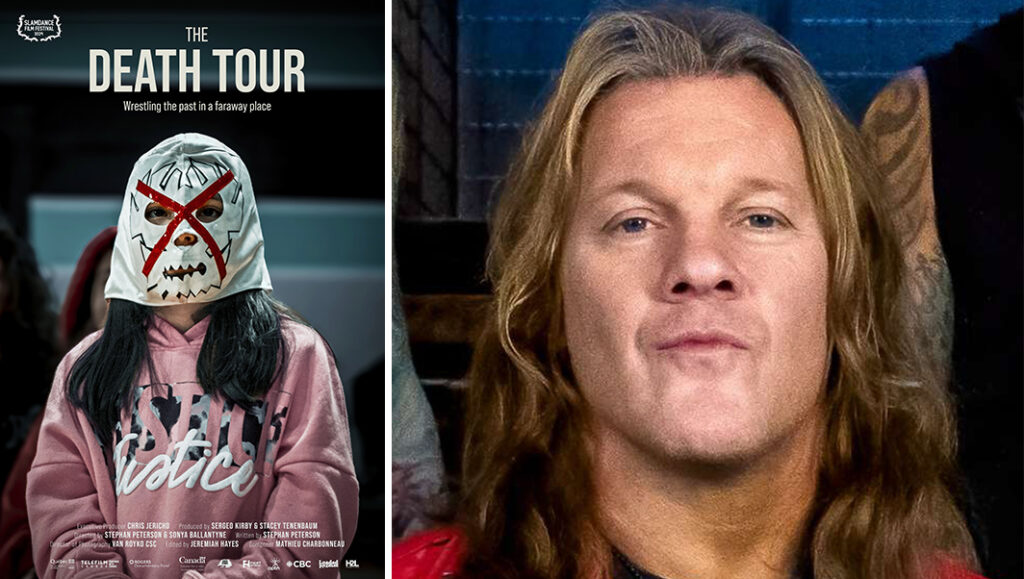Slamdance 2024 Interview: Chris Jericho Brings Us Inside the Ring of ‘The Death Tour’

Over his thirty-year career, Chris Jericho has solidified his place as one of wrestling’s most prolific and notable showmen. Often referred to as the Greatest of All Time, Jericho is an eight-time world champion who recently executive produced the must-see documentary, The Death Tour.
Every winter, when the lakes freeze over, a motley gang of professional wrestlers leaves Winnipeg on a one-of-a-kind wrestling trip through remote Indigenous communities of Northern Manitoba. Wrestling insiders call it the “Death Tour”—both for the physical hardships endured on the road and the emotional toll it takes on those who experience it. Famous for its star-studded alumni, the trip offers wrestlers a rare taste of fame and a chance to see if they have what it takes to make it in professional wrestling. This deeply personal documentary travels through Canada’s frozen North and into the wrestlers’ minds as they battle the elements, each other, and the impacts of our colonial past.
Chris brought us inside the ring of The Death Tour documentary, which recently made its premiere at the Slamdance Film Festival.
PC: You are such a legend in this industry. How did The Death Tour come across your desk? What was it about this documentary that made you want to be a part of it?
Chris: It’s one of those things that I’ve lived through. I’ve been on a Death Tour. More importantly, the legend of it, I’ve been familiar with for years. So many of my peers and contemporaries did the Death Tour and had so many great stories to say about it. When I heard about this documentary getting made and they asked me to come onboard as a producer, I knew that I’d be able to contribute, not just from a wrestling standpoint, but from a personal experience standpoint, and knowing how important these tours are to an individual to prove to yourself and to others that you have what it takes to be in this business because it’s not easy. The early days, especially, you have to fight and claw your way into getting gigs. As hard as the Death Tour is, so many people want to do it because it’s work and because they’ve heard so much about it. It’s about experiencing it for themselves and seeing if it’s as bad or as good as people are saying.
PC: As you were saying, for so many of these up-and-coming wrestlers, this is their first glimpse into this world, the community, and its impact. As you were executively producing this film and seeing firsthand the experiences, did that bring any memories from when you first started? Given all the success that you’ve had, when you look back, is there a moment that stands out?
Chris: As far as one of these tours, it was just being involved in one, and the fact that it’s been going on for so many decades. You hear about it in the documentary that you’re driving sixteen hours on a frozen lake. That might sound like an adventure to us talking about it right now, but when you’re actually doing it, it really sucks. It’s cold, tedious, arduous, and dangerous. We talked about it in the movie how the lake cracks and these vans are going down a couple of feet in the water; that’s terrifying. So you’re doing this because you want to advance your career or you want to build your career, but there’s also a physical danger too. The whole concept of it is fantastic. But what we really captured in this film was so much more than that. The individual stories of the wrestlers and the individual stories of the towns that the shows are coming to. There’s not a lot going on in Northern Manitoba, Bloodvein, God’s Lake, and all these places. When wrestling comes into town, it’s like the [Rolling] Stones. It’s like WrestleMania. It’s like the biggest thing ever, whether there’s a 100 people there or 500 people there. That’s something they’re going to remember for the rest of their lives. There’s a lot of influence in that, so I think we were able to capture that in the film as well and how important it is for the wrestling show to come to town and what that means to people in the ring and the people out of it.
PC: There’s a moment in the documentary where Massive Damage discusses how he almost quit the sport, but it’s about having that one person who believes in you and the impact that they could have on your career. Who was the person for you that influenced your own wrestling career?
Chris: That’s the story of Massive Damage. The story of Chris Jericho, there was never a moment where I ever considered quitting. There was no backup or safety net, so who was that person? It was me because I believed in myself. I was lucky that I had a full-time job wrestling in Mexico and Japan, so I didn’t have to worry about the Death Tours every February when they came around. All my contemporaries were going on them. I was like, “Wow, I’m happy that I’m in Tokyo this week.” But if I wasn’t, if I didn’t have those gigs, I would have been first in line to give Tony Condello my tape, pictures and say, “Hey, dude. Can I come with you again this year?” Like I said, it was work. It was this badge of honor, like, “Here we go, man. You know how hard it’s going to be, so let’s grit our teeth and bear it.” The time that you spend in the ring is almost the payoff. It’s the reward for doing this trip. But it’s the other twenty-three hours traveling that set the tone as to whether you have what it takes to be in this business.
PC: I’m sure you get asked this all the time, but the wrestling industry isn’t an easy one to be a part of. We see in this documentary the sacrifices that you all have to make to be at the top of this sport. If you were to give advice to any up-and-coming wrestler who’s trying to make it in this industry, what would it be and why?
Chris: You have to work as much as you can when you first start out. You have to get those reps and that experience. That’s why some of the Death Tours are so valuable to young wrestlers. You’re getting so many matches in a short period of time, so you’re really getting those reps, which is what you need to understand your character and how to control a crowd. Again, you’re also learning lessons outside of that. You’ll never forget what it’s like traveling across the frozen lake. You’ll never forget that. Those are experiences that are so invaluable that we wanted to really capture on camera and not just the grueling nature of it, but the fun part of it too, the beauty of it, and the things that you’ll see on this tour that you’ll never see anywhere else. There are a lot of benefits and great memories. I think back to the one that I did and there are so many great memories that I can think of. For all of my contemporaries, you could make another documentary about the Death Tour that’s all the hilarious, ridiculous stories that happened. We touch on that a bit in this as well. But we went so much deeper on this one. But you could make another documentary about the stories you could tell about being on it.
PC: Stephan [Peterson] has been really open about the fact that he doesn’t come from this world. What was it like getting to collaborate with him and Sonya [Ballantyne] and bring them into your world, and make sure that authenticity is displayed on screen?
Chris: That’s why when the idea came up of me being involved as an executive producer, I was really interested in it because there are so many movies about wrestling, and they never resonate because people don’t understand it because it’s a very difficult world to understand. You can say, “Oh, yeah. You’re wrestling.” But wrestling is neither fish nor fowl, and dealing with wrestlers and people that want to be wrestlers, we’re all insane. You have to be to be in this job. For me to be involved in it and tighten the screws, dot the I’s and cross the T’s, it was important to me, looking at it from a filmmaker standpoint, I think it’s good to have another set of eyes and being like, “This story needs to be more developed. Do we have more footage of this? Or this story is too long, we need to cut this down. It’s tedious. Sometimes when you’re an artist, you think everything that you’re doing is genius. Then you have somebody else who’s like, “This could be better.” That’s the creative head butting that’s good. It’s frustrating at times, but it’s also good. That’s what makes award-winning films or films that premiere at festivals as prestigious as Slamdance, where thousands of films are being submitted and ours is one that’s chosen. There’s a reason for that. This is really good, and there’s a reason why it’s really good. You have great creative minds working on it to put the best possible film you could make.
PC: One of the beautiful things about filmmaking is its ability to bring awareness to timely subject matter like the suicide epidemic that these Indigenous communities are facing. What do you hope audiences take away after they see this at Slamdance?
Chris: That’s the story of the film that really resonates is how hard it is for these people to be living on these reservations and how much of a breath of life and a beam of light it is when wrestling comes to town because what else is coming to town? The Stones aren’t coming to Bloodvein, Manitoba. That’s something else we were able to capture—how important it is to these communities that these shows are coming through because there is so much darkness. To be able to bring that light is very important. It’s called the Death Tour, but nobody is literally dying. But we’re talking about how hard and grueling it is. But when the tour comes to town, there’s nothing dark about it. It’s a very positive, enlightening experience for the people in the ring and people watching outside the ring.
To keep up with Chris, follow him on Twitter and Instagram. The Death Tour make its world premiere at the Slamdance Film Festival.


Discussion about this post